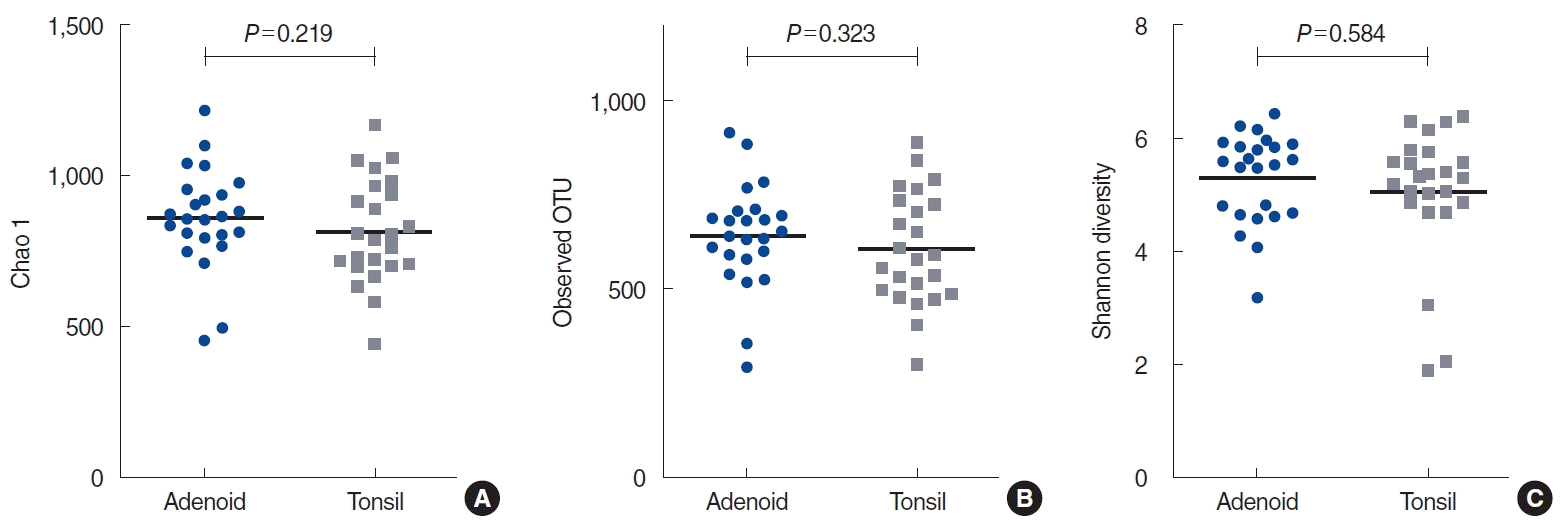1. Gerhardsson H, Stalfors J, Odhagen E, Sunnergren O. Pediatric adenoid surgery in Sweden 2004-2013: incidence, indications and concomitant surgical procedures. Int J Pediatr Otorhinolaryngol. 2016; Aug. 87:61–6.

2. Juul ML, Rasmussen ER, Rasmussen SH, Sorensen CH, Howitz MF. A nationwide registry-based cohort study of incidence of tonsillectomy in Denmark, 1991-2012. Clin Otolaryngol. 2018; Feb. 43(1):274–84.

3. Zautner AE. Adenotonsillar disease. Recent Pat Inflamm Allergy Drug Discov. 2012; May. 6(2):121–9.
4. Johnston J, Hoggard M, Biswas K, Astudillo-Garcia C, Radcliff FJ, Mahadevan M, et al. Paired analysis of the microbiota between surface tissue swabs and biopsies from pediatric patients undergoing adenotonsillectomy. Int J Pediatr Otorhinolaryngol. 2018; Oct. 113:51–7.

5. Xu Z, Wu Y, Tai J, Feng G, Ge W, Zheng L, et al. Risk factors of obstructive sleep apnea syndrome in children. J Otolaryngol Head Neck Surg. 2020; Mar. 49(1):11.

6. Johnston J, Hoggard M, Biswas K, Astudillo-Garcia C, Waldvogel-Thurlow S, Radcliff FJ, et al. The bacterial community and local lymphocyte response are markedly different in patients with recurrent tonsillitis compared to obstructive sleep apnoea. Int J Pediatr Otorhinolaryngol. 2018; Oct. 113:281–8.

7. Tsaoussoglou M, Lianou L, Maragozidis P, Hatzinikolaou S, Mavromati M, Orologas N, et al. Cysteinyl leukotriene receptors in tonsillar B- and T-lymphocytes from children with obstructive sleep apnea. Sleep Med. 2012; Aug. 13(7):879–85.

8. Fago-Olsen H, Dines LM, Sorensen CH, Jensen A. The adenoids but not the palatine tonsils serve as a reservoir for bacteria associated with secretory otitis media in small children. mSystems. 2019; Feb. 4(1):e00169–18.

9. Maw AR. Chronic otitis media with effusion and adeno-tonsillectomy: a prospective randomized controlled study. Int J Pediatr Otorhinolaryngol. 1983; Dec. 6(3):239–46.
10. Min HJ, Park JS, Kim CE, Kim KS. Profiling of heat shock proteins 27 and 70 in adenoids of children. Eur Arch Otorhinolaryngol. 2019; Sep. 276(9):2483–9.

11. WHO Collaborating Center for Asthma and Rhinitis, Bousquet J, Anto JM, Demoly P, Schunemann HJ, Togias A, et al. Severe chronic allergic (and related) diseases: a uniform approach: a MeDALL-GA2LEN-ARIA position paper. Int Arch Allergy Immunol. 2012; 158(3):216–31.
12. Kim JK, Yoon YM, Jang WJ, Choi YJ, Hong SC, Cho JH. Comparison study between MAST CLA and OPTIGEN. Am J Rhinol Allergy. 2011; Jul-Aug. 25(4):e156–9.

13. Hyun DW, Min HJ, Kim MS, Whon TW, Shin NR, Kim PS, et al. Dysbiosis of inferior turbinate microbiota is associated with high total IgE levels in patients with allergic rhinitis. Infect Immun. 2018; Mar. 86(4):e00934–17.

14. Ishman SL, Yang CJ, Cohen AP, Benke JR, Meinzen-Derr JK, Anderson RM, et al. Is the OSA-18 predictive of obstructive sleep apnea: comparison to polysomnography. Laryngoscope. 2015; Jun. 125(6):1491–5.

15. Hamady M, Walker JJ, Harris JK, Gold NJ, Knight R. Error-correcting barcoded primers for pyrosequencing hundreds of samples in multiplex. Nat Methods. 2008; Mar. 5(3):235–7.

16. Caporaso JG, Kuczynski J, Stombaugh J, Bittinger K, Bushman FD, Costello EK, et al. QIIME allows analysis of high-throughput community sequencing data. Nat Methods. 2010; May. 7(5):335–6.

17. Kim J, Bhattacharjee R, Dayyat E, Snow AB, Kheirandish-Gozal L, Goldman JL, et al. Increased cellular proliferation and inflammatory cytokines in tonsils derived from children with obstructive sleep apnea. Pediatr Res. 2009; Oct. 66(4):423–8.

18. Segata N, Izard J, Waldron L, Gevers D, Miropolsky L, Garrett WS, et al. Metagenomic biomarker discovery and explanation. Genome Biol. 2011; Jun. 12(6):R60.

19. Wang X, Li H, Bezemer TM, Hao Z. Drivers of bacterial beta diversity in two temperate forests. Ecol Res. 2016; Jan. 31:57–64.

20. Vicente E, Marin JM, Carrizo SJ, Osuna CS, Gonzalez R, Marin-Oto M, et al. Upper airway and systemic inflammation in obstructive sleep apnoea. Eur Respir J. 2016; Oct. 48(4):1108–17.

21. De Boeck I, Wittouck S, Martens K, Claes J, Jorissen M, Steelant B, et al. Anterior nares diversity and pathobionts represent sinus microbiome in chronic rhinosinusitis. mSphere. 2019; Nov. 4(6):e00532–19.

22. Liu P, Wu L, Peng G, Han Y, Tang R, Ge J, et al. Altered microbiomes distinguish Alzheimer’s disease from amnestic mild cognitive impairment and health in a Chinese cohort. Brain Behav Immun. 2019; Aug. 80:633–43.

23. Jiang H, Ling Z, Zhang Y, Mao H, Ma Z, Yin Y, et al. Altered fecal microbiota composition in patients with major depressive disorder. Brain Behav Immun. 2015; Aug. 48:186–94.

24. Perry M, Whyte A. Immunology of the tonsils. Immunol Today. 1998; Sep. 19(9):414–21.

25. Johnston JJ, Douglas R. Adenotonsillar microbiome: an update. Postgrad Med J. 2018; Jul. 94(1113):398–403.

26. Aktepe F, Sahin O, Dilek H, Yilmaz D, Kahveci O, Derekoy S. Immunohistochemical assesment of heat shock protein 70 in adenoid tissue. Int J Pediatr Otorhinolaryngol. 2007; Jun. 71(6):857–61.

27. Reddy VS, Madala SK, Trinath J, Reddy GB. Extracellular small heat shock proteins: exosomal biogenesis and function. Cell Stress Chaperones. 2018; May. 23(3):441–54.

28. Dogru M, Evcimik MF, Calim OF. Does adenoid hypertrophy affect disease severity in children with allergic rhinitis. Eur Arch Otorhinolaryngol. 2017; Jan. 274(1):209–213.








 PDF
PDF Citation
Citation Print
Print



 XML Download
XML Download